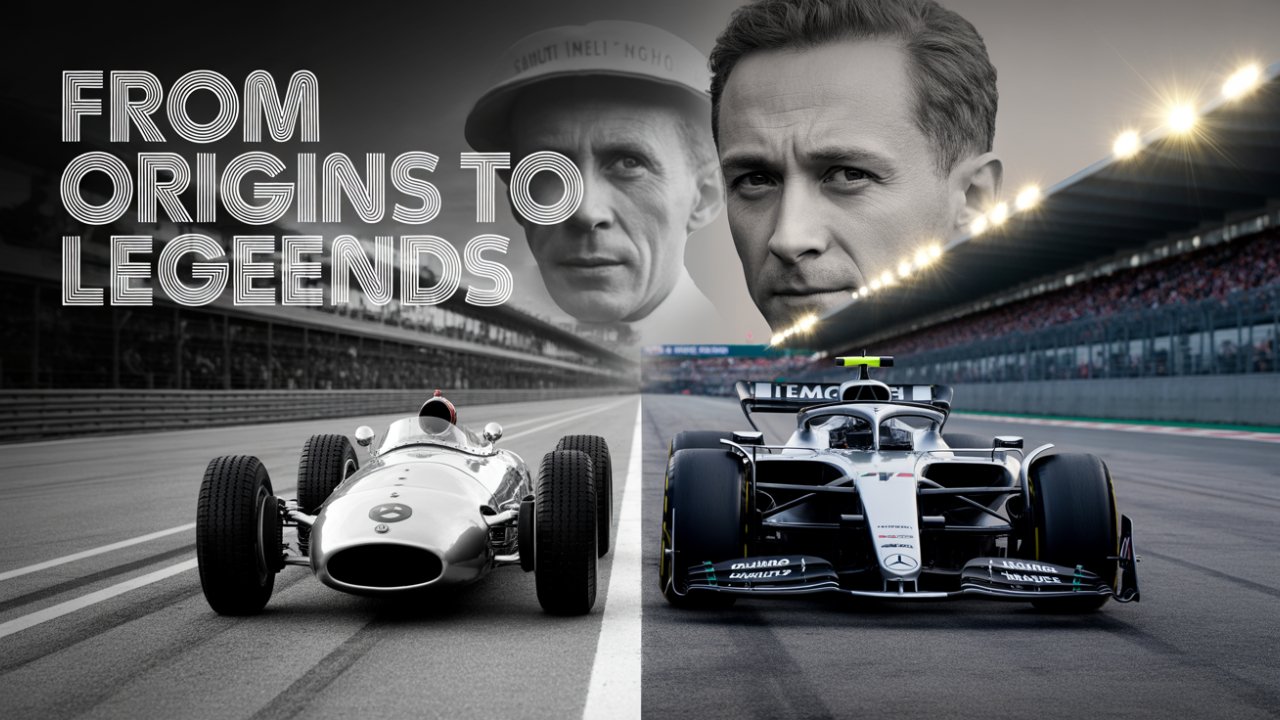From the deadly road races of the 1950s to the technological marvels we see today… this is the story of how a daring sport for gentlemen racers evolved into a global sensation. This is Formula 1, from its origins to its legends.
It’s a sport defined by the smallest margins. A fraction of a second is the difference between glory and despair, a spot on the podium and a disastrous crash. It’s a world of crushing pressure, where drivers and engineers constantly push the limits of physics and human endurance. But Formula 1 is so much more than just a race. It’s a story of human drama, technological warfare, and an obsessive chase for perfection. A story whose championship era kicked off on a forgotten airfield in England and grew into a multi-billion-dollar spectacle that captivates millions. So, how did it happen? How did a niche European championship become the undisputed king of motorsport? This is that story.
The Birth of a Legend – The 1950s
Our story really gets going in the aftermath of World War II. As Europe was rebuilding, so was the spirit of competition. Grand Prix racing, which had already thrilled crowds for decades, was ready for a comeback. In 1946, the newly formed Fédération Internationale de l’Automobile, or FIA, standardized the rules for single-seater racing, creating the “formula” that gives the sport its name.
Then, on May 13th, 1950, at Silverstone Circuit in the UK, history was made. The first-ever official FIA Formula One World Championship race roared to life. The cars were a completely different world from what we see today. They were brutal, front-engined machines with skinny tires, no seatbelts—can you imagine?—and minimal safety features. Driving them demanded a wild blend of courage and skill. The top dog of the day was Alfa Romeo, whose pre-war Alfetta 158 was an engineering masterpiece. An Italian driver, Giuseppe “Nino” Farina, would take that Alfa Romeo and become the very first Formula 1 World Champion.
But the decade would truly be defined by one man: Juan Manuel Fangio. The Argentinian, nicknamed “El Maestro,” was a master of his craft. He was a balding, stocky man already in his 40s when he joined the sport, yet he drove with a grace and precision that just left his rivals speechless. Fangio’s genius was his adaptability; he won five world championships with four different manufacturers: Alfa Romeo, Ferrari, Mercedes-Benz, and Maserati. That’s a record that stood for nearly 50 years and cemented his status as the sport’s first true legend.
This era was raw and incredibly dangerous. The cars were powerful, but the tracks were unforgiving—often just country roads lined with trees, ditches, and buildings. Safety was an afterthought, and drivers knew that any mistake could be their last. Yet, this very danger created heroes. Men like Fangio, Alberto Ascari, and Britain’s Stirling Moss—often called the greatest driver never to win a championship—risked it all for the love of speed. They were the pioneers, the gentlemen racers who laid the foundation for the global phenomenon F1 would become.
The British Invasion and Innovation – The 1960s
As the 50s rolled into the 60s, the power dynamic in Formula 1 started to flip. The big, factory-backed Italian and German teams were suddenly being challenged by a new wave of brilliant, scrappy, and often broke British teams. Enzo Ferrari famously called them “garagistes,” or “garage-dwellers.” These small, agile teams, led by engineering geniuses, were about to revolutionize the sport.
The biggest change came from car design. The heavy, front-engined cars of the 50s were instantly made obsolete by the mid-engine layout, pioneered by Cooper, which massively improved weight distribution and handling. But the real game-changer came in 1962 from the legendary Colin Chapman of Lotus. His Lotus 25 was the first F1 car to feature a monocoque chassis, an aircraft-inspired design where the car’s skin is part of the structure. It made the car lighter, stiffer, and just flat-out better than the old tube-frame designs. It was a leap so huge, everything else was instantly outdated.
This British engineering brilliance was matched by a new crop of supremely talented drivers. The decade was dominated by stars from Britain and the Commonwealth, like Jack Brabham, Graham Hill, and Jackie Stewart. But maybe the most gifted of them all was a quiet Scottish farmer named Jim Clark. Driving for Lotus, Clark seemed to have a sixth sense for what his car was doing. His smooth, almost effortless style hid an incredible raw speed. He won two World Championships, in ’63 and ’65, and was practically unbeatable. His tragic death in a Formula 2 race in 1968 sent shockwaves through the sport and robbed it of one of its brightest lights.
Another giant of the era was Graham Hill, the only driver in history to win the Triple Crown of Motorsport: the Monaco Grand Prix, the Indianapolis 500, and the 24 Hours of Le Mans. His two F1 titles in ’62 and ’68 proved his incredible versatility and grit.
The 60s also saw the first real experiments with aerodynamics. Teams started bolting wings onto their cars, at first on these tall, wobbly stilts, to create downforce and stick the cars to the track in corners. This, plus a 1966 rule change that doubled engine size to 3 liters, meant speeds were climbing higher and higher. The cars were getting faster, but safety was lagging behind—a tension that would explode in the next decade.
The Golden Age of Glamour and Danger – The 1970s
The 1970s were a decade of wild contradictions. It was an era of glamour, big money, and exploding popularity, but it was also one of the deadliest periods in the sport’s history. The cars were now wrapped in the colorful logos of tobacco and commercial sponsors, turning the grid into a vibrant, moving billboard. Aerodynamics became the new obsession, with designers creating wild-looking cars to master the power of downforce.
This was the decade of the playboy driver, and nobody lived that role better than Britain’s James Hunt. Charismatic, handsome, with a rockstar lifestyle off the track, Hunt was a massive fan favorite. His driving style was pure aggression. His polar opposite was the Austrian, Niki Lauda. Lauda was cool, calculating, and methodical—a driver who used his brain as much as his right foot. They called him “The Computer.”
Their completely different styles and personalities fueled one of the most legendary rivalries in all of sports, which came to a head in the dramatic 1976 season. Lauda, the champ for Ferrari, was dominating. But at the terrifying Nürburgring circuit in Germany, disaster struck. Lauda had a horrific, fiery crash that left him with severe burns and life-threatening lung damage. It was an accident that should have ended his career.
Incredibly, just six weeks later, in an act of almost unbelievable courage, Lauda was back in his Ferrari, his wounds still bandaged, to keep fighting Hunt for the title. It all came down to the final race in Japan, held in pouring rain. Lauda, feeling the conditions were just too dangerous, pulled into the pits and retired—a decision that cost him the championship but probably saved his life. Hunt finished third, which was just enough to win the title by a single point. The story was so epic it was later made into the movie “Rush.” And while they were portrayed as bitter rivals, the two were actually good friends, a sign of the deep respect they had for each other.
The 70s also gave us other legends like two-time champ Emerson Fittipaldi and the great Jackie Stewart, who won his third and final title in 1973. Stewart became a tireless crusader for safety, a campaign that, after a horrible string of tragedies, finally began to change the sport for the better. The 70s were a brutal, brilliant, and transformative decade that cemented F1’s place on the world stage.
The Turbo Era and Titanic Rivalries – The 1980s
If the 70s were about aero, the 80s were all about raw, unfiltered power. Welcome to the Turbo Era. Renault introduced the first turbo engine back in ’77, but it was in the 80s that the tech really took over, kicking off an arms race that saw horsepower numbers go through the roof. These tiny 1.5-liter engines could produce well over 1,000 horsepower in qualifying—some estimates say close to 1,500. It took a special kind of driver to tame these monstrously powerful and laggy “turbo bombs.”
The decade gave us some of the sport’s greatest champions, like Nelson Piquet and Niki Lauda, who clawed his way to a third title in 1984. But the era would be defined by the colossal, all-consuming rivalry between two men who became teammates at McLaren in 1988: the Frenchman Alain Prost and the Brazilian Ayrton Senna.
They couldn’t have been more different. Prost, “The Professor,” was a four-time champion known for his smooth, intelligent, and calculated racing style. He played the long game, saving his car and tires, just stacking up points with ice-cold consistency. Senna, on the other hand, was a force of nature. He was a driver with mind-blowing natural talent and an almost spiritual connection to his car. He drove with a fiery intensity, pushing himself and his machine to the absolute limit, especially in the rain, where he was simply untouchable.
Putting them on the same team was both spectacular and explosive. In 1988, their McLaren MP4/4 was one of the most dominant cars ever, winning 15 of the 16 races. But their internal fight for the crown was vicious and often personal. It was a psychological war. Prost had his clinical, percentage-based approach, while Senna seemed to believe he had a divine right to win, no matter what it took.
Their rivalry boiled over in two infamous championship-deciding crashes at the Japanese Grand Prix. In 1989, Prost turned in on Senna, and the resulting disqualification handed Prost the title. A year later, with Prost now at Ferrari, Senna intentionally drove Prost off the track at the first corner to secure the championship for himself. It was a rivalry that split fans down the middle and showed the dark, ruthless side of the will to win. The cold Professor versus the passionate Artist—it’s still the most iconic and brutal rivalry the sport has ever seen.
The Schumacher Dynasty and a New Era of Safety – The 1990s-2000s
The end of the turbo era in 1988 brought back naturally aspirated engines, but the sport didn’t get any less intense. The early 90s were still all about the epic Senna vs. Prost battle, but a dark cloud fell over Formula 1 at the 1994 San Marino Grand Prix.
That weekend at Imola was one of the darkest in F1 history. It started with a horrifying crash for Rubens Barrichello, then the tragic death of driver Roland Ratzenberger in qualifying. Then, during the race, the world watched in horror as Ayrton Senna’s car shot off the track at the high-speed Tamburello corner and slammed into a concrete wall. The brilliant Brazilian, arguably the most gifted driver of all time, was killed.
The death of a figure as huge as Senna was a wake-up call for Formula 1. The sport had gotten complacent, and Senna’s death forced a complete overhaul of safety. FIA President Max Mosley led a safety revolution. Cockpits were made stronger, crash test standards became way stricter, tracks were redesigned, and life-saving gear like the HANS device became mandatory. The changes were massive, and they have saved countless lives since.
Out of this tragedy, a new superstar emerged who would completely redefine what dominance looked like in F1: Michael Schumacher. The German driver had already won his first title with Benetton in that tragic ’94 season and a second in ’95. But it was his move to a struggling Ferrari team in 1996 that would build his legacy.
Schumacher, along with team boss Jean Todt and technical director Ross Brawn, set out to rebuild the legendary Italian team. It was a long, hard road, but Schumacher’s insane work ethic, incredible talent, and ability to rally the team were the driving forces. The breakthrough came in the year 2000. Schumacher won the driver’s championship, Ferrari’s first in 21 years.
It was the start of a winning streak nobody had ever seen before. From 2000 to 2004, Schumacher and Ferrari were unbeatable, winning five straight driver’s titles and six straight constructor’s championships. Schumacher smashed almost every record in the book, including Fangio’s long-standing record of five world titles. He set a new bar at seven championships, a number most people thought was untouchable. He also changed the game for driver fitness and commitment, turning the F1 driver into a complete elite athlete. This era also saw the rise of new challengers who would finally break his hold, including the fiery Fernando Alonso, who won two titles with Renault, and the ice-cool Kimi Räikkönen, who snagged the 2007 title for Ferrari.
The Hybrid Era and Modern Legends – 2010s-Present
The late 2000s and early 2010s saw another power shift. A young German driver named Sebastian Vettel, in a Red Bull car designed by aero-genius Adrian Newey, took the sport by storm. From 2010 to 2013, Vettel was untouchable, winning four straight world championships and becoming the youngest-ever champ at the time.
But in 2014, Formula 1 went through its biggest technical shake-up yet. To be more efficient and relevant to road cars, the sport switched from V8 engines to complex 1.6-liter V6 turbo-hybrid power units. These new engines combined a traditional engine with powerful energy recovery systems, creating some of the most efficient racing engines ever.
One team nailed this new formula way better than anyone else: Mercedes. Their power unit was an engineering marvel, giving them a massive head start that would kick off one of the most dominant periods in F1 history. And at the center of it all was a British driver about to go on a record-smashing journey: Lewis Hamilton.
Hamilton had already won a title with McLaren back in 2008, becoming the sport’s first Black driver and world champion. But his move to Mercedes in 2013 was a stroke of genius. Over the next seven years, Hamilton and Mercedes rewrote the F1 record books. He won six more world titles, including four in a row from 2017 to 2020. That year, he tied Michael Schumacher’s legendary record of seven World Drivers’ Championships. He then surpassed Schumacher’s record for most race wins and now holds the records for most pole positions and podium finishes. Beyond the track, Hamilton has become a global icon, using his massive platform to fight for diversity, inclusion, and social justice.
The Mercedes dominance was finally challenged by the rise of a new generational talent, the Dutch driver Max Verstappen. Aggressive, supremely confident, and blisteringly fast, Verstappen’s rivalry with Hamilton blew up into one of the most intense and controversial title fights ever in the 2021 season. The fight went down to the very last lap of the final race, where Verstappen snatched the championship away, signaling a changing of the guard and kicking off a new era of fierce competition.
Formula 1’s story is one of constant change, of legends who defined their time, and of technology that keeps pushing the absolute limits of what’s possible. From Fangio to Hamilton, from the Alfetta to the hybrid beasts, the sport never, ever stands still.
If you enjoyed this trip through F1 history, make sure to hit that like button, subscribe for more stories from the world of motorsport, and let us know in the comments: who is your ultimate Formula 1 legend?
(From its humble post-war start at Silverstone, Formula 1 has grown into a global sporting giant. It’s this unique mix of high-stakes human drama and mind-bending technology. The story of F1 is written in the rivalries between drivers like Hunt and Lauda, Prost and Senna, Hamilton and Verstappen. It’s etched in the heroic comebacks and the tragic losses that sparked a safety revolution. And it’s built by iconic teams like Ferrari, McLaren, Lotus, and Mercedes that have never stopped pushing the boundaries of what a car can do.
The faces and the cars will always change, but the heart of Formula 1 stays the same: a relentless, high-speed chase for perfection. It’s a sport that honors its past while always racing full-throttle into the future. The next corner, the next big idea, the next legend—they’re always just around the bend. And that’s why, after more than seventy years, Formula 1 is still the undisputed pinnacle of motorsport.





